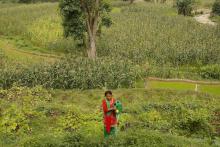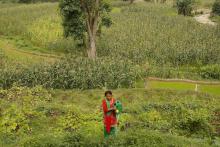When crises hit, not everyone is affected quite the same way. Crises intersect with and exacerbate existing inequalities. Challenges of climate change and its disproportionate impacts on women have been compounded by the recent COVID-19 pandemic, war in Ukraine, and cost-of-living crisis. All of these have had a crippling effect on achieving the Sustainable Development Goals (SDG), especially on SDG 5 on gender equality.
To understand the extent of these impacts and to put in place relevant crises responses and sustain policy action on the SDGs, it’s critical we have a clear picture through gendered statistics.
It will take 22 years to close SDG gender data gaps
As of June 2022, we have 42 per cent of the gender data we need to monitor the gender-specific dimensions of the SDGs—up from 26 per cent in 2016, an annual increase of 3 percentage points. Even though we have a long way to go, this progress should still be celebrated, considering how data collection has been severely affected globally during the pandemic. In May 2020, 90 per cent of National Statistical Offices in low- and lower middle-income countries were struggling to meet international reporting requirements.
Partnerships drive success in gender data production
Since 2016, UN Women’s global gender data programme, Women Count, has been supporting efforts to improve the regular production of gender statistics, including providing financial and technical support to improve data collection so that we can better monitor the SDGs. Of the 10 Women Count countries, nine have at least half of the SDG gender data available.
Data availability of gender-specific SDG indicators of Women Count countries, September 2019 and June 2022
A long way to go on data availability
Of the 193 countries who committed to Agenda 2030, no one country has all the data available on gender-specific SDG indicators. If we continue at the historical average annual rate of increase of 3 percentage points, it will take 22 years for countries to make all SDG gender data available, more than a decade past the 2030 deadline for the SDGs.
Mexico, Armenia, Belarus, Guatemala, Ecuador, Peru, Costa Rica, Albania, Panama and Zimbabwe currently have the most SDG gender data available. Applying country-specific rates of progress between 2019 and 2022, these countries would be able to make available all SDG gender data before 2030, except for Costa Rica. Even this is not good enough. To take programmatic and policy actions towards achieving our 2030 targets, we need gender data now.
SDG gender data availability, June 2022
Ten countries with the highest percentage of SDG gender data availability and years needed to achieve 100% data availability
On the other end of the spectrum, the list of countries with the lowest SDG gender data availability is mainly dominated by small islands and nations—Monaco, Saint Kitts and Nevis, San Marino, Liechtenstein, Andorra, Bahamas, Micronesia, Dominica, Grenada and Eritrea. In order to reach 100% data availability it will take between 39 (Eritrea) and 220 years (Monaco). That’s just too long. We need to exponentially increase deliberate efforts in making gender data available.
Ten countries with the lowest percentage of SDG gender data availability and years needed to achieve 100% data availability
To address these challenges faced by all countries, the rate of progress must be significantly improved.
On average, every country must make advancements by 6 percentage points each year to achieve 100 per cent gender data availability by 2030. Much remains to be done. Even seven years into Agenda 2030, there are 14 gender-specific indicators where no data has been reported for any country. These include, among others, women subject to sexual violence (SDG indicators 5.2.2, 11.7.2), women living below 50 per cent of median income and the national poverty line (10.2.1; 1.2.1), and hourly earnings of women employees (8.5.1).
For some key indicators, we have reached more than 95 per cent data availability. These include the proportion of seats held by women in national parliaments (5.5.1); adolescent birth rate (3.7.2); unemployment rate (8.5.2); maternal mortality ratio (3.1.1); and births attended by skilled health personnel (3.1.2.).
Investments, commitments and action
Despite the growing need for gender data to better understand and manage ongoing global crises and challenges, funding levels are scarce and remain far below what’s needed. The Partner Report on Support to Statistics (PRESS) 2021 found a stagnant trend in financing gender data and statistics projects from Development Assistance Committee (DAC) donors, with little change in funding after a significant boost around 2015. However, the latest report from Data2X on the State of Gender Data Financing 2021 finds that until 2030, $500 million a year is needed, double what is currently allocated.
We must re-double our efforts to invest in data production and the use of more and better gender data to understand and address the medium- and long-term effects of the pandemic, war in Ukraine, and cost-of-living crisis. Data is the best way to spur evidence-based and gender-responsive policy action and leave no one behind. The 2022 edition of Progress on the Sustainable Development Goals: The Gender Snapshot 2022 brings together the latest available evidence on gender equality across all 17 Goals, highlighting the progress made since 2015 but also the continued alarm over the COVID-19 pandemic and its immediate effect on women’s well-being, including the threat it poses to future generations.

